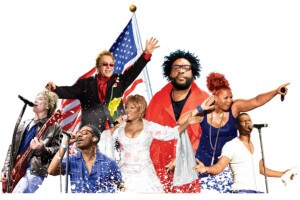How the Flyers’ Social Media Geniuses Made the World Love Gritty
They set out to create a mascot. Instead, they started a revolution.
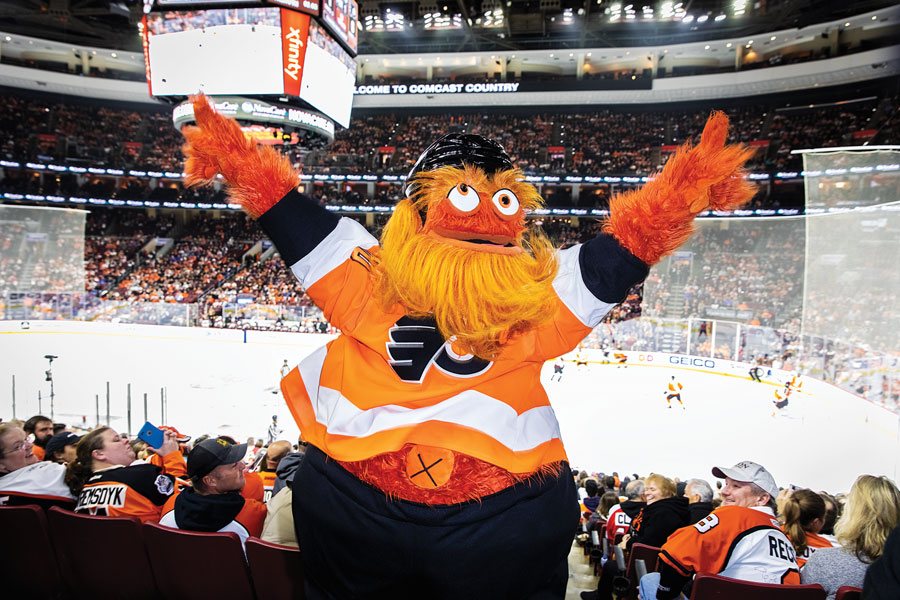
Gritty, America’s favorite orange fuzzball, at a game in November. Photograph by Steve Boyle.
On day one, it was a tale of two Grittys.
In person, the neck-beardy orange fuzzball was an instant success. Bolstered by balloons and confetti and smoke machines and a t-shirt-launching ATV, the Flyers’ marketing team had just unveiled the club’s new mascot to a hall full of children at the Please Touch Museum. The kids shrieked in delight at his big belly, broad smile and goofy gyrations. It was, by all accounts, a home run of an event. A pure expression of glee.
But over on Twitter, the wretched id of the internet, people were not amused. Or, rather, they were too amused. From the moment of the mascot’s first tweet — “It me. #Gritty” — at 11:17 a.m. on Monday, September 24, 2018, Twitter did what Twitter does: It crucified the creature. And it didn’t stop there: It pilloried the marketing team, the Flyers, and Philadelphia for good measure. Mostly, the haters focused on Gritty’s wide, googly eyes, which in photos can take on a manic, nightmarish quality depending on their orientation when the shutter snaps.
It me. #Gritty pic.twitter.com/HfTMVtEAFy
— Gritty (@GrittyNHL) September 24, 2018
“Looks like he took a speedball.” “A dollar-store version of the Phanatic.” “Internalized screaming and paranoia.” “Someone needs to get fired over this.” “WTF?”
It was the sort of frenzy usually reserved for celebs delivering non-apology apologies or corporations making clumsy appeals to millennials. There was snark. There was blunt derision. There were memes and Photoshops. And there were GIFs. So many goddamn GIFs.
At the Please Touch Museum, still basking in the good vibes, the eight-member squad of Flyers employees who’d been tasked with creating and launching the Flyers’ first mascot in 39 years had retreated to a back room to collect their things before returning to the Wells Fargo Center. An hour later, not one of them had left that room.
“We could not stop reading Twitter,” says Joe Heller, the Flyers’ VP of marketing and communications, of the vortex his team had been sucked into. “It kept coming in.”
Social media coordinator Lauren Robins recalls the awe and dread in the room: “It was like, ‘Did anyone see this one?’ ‘Did anyone see this one?’”
“The event went off without a hitch, and those kids were fired up,” recounts Sarah Schwab, director of marketing and communications. “We thought, ‘Well, this is good — 600 kids responding really well.’ And then you look down at your phone and you’re like, ‘Oh, this is what we expected.’”
Of course they saw it coming. They’re marketers, after all, and social media natives besides. But more importantly, they were prepared because from the moment they embarked on this project, they had been coached to be. And what happened in that room — what the Gritty Brain Trust did in that hour — would change everything.
At 12:03, the Pittsburgh Penguins “threw us the best possible bone,” says digital media manager Christine Mina. The loathed cross-state rivals responded to Gritty’s initial tweet with six characters: “lol ok.” Nine minutes later, @GrittyNHL returned serve: “Sleep with one eye open tonight, bird.”
“It gave us the opportunity to help him defend the city,” says Mina.
Sleep with one eye open tonight, bird. pic.twitter.com/wLmGBa0Oyh
— Gritty (@GrittyNHL) September 24, 2018
While the Twitter roast of Gritty would continue for most of the rest of the day, spreading out from Philly like an epidemic, that clapback contained multitudes. It drew a line in the sand. It said, If you fuck with the Flyers — if you fuck with Philly — I, Gritty, can’t be held responsible for what happens next. So when the Twitter storm left Philly, when it became the rest of the country piling on, the tide turned. It’s one thing for Philadelphians to give the Flyers mascot a raft of shit. It’s quite another for anyone else to. And that’s how a supposed marketing fail pivoted into the most successful mascot launch basically ever — and a full-fledged international obsession.
Within hours, the mascot was on Good Morning America. A few days later, it was clowning with Fallon. SNL and John Oliver and Conan all did their takes. Gritty was trending for days, producing some 4.8 billion views across TV and the web, worth an estimated $162 million of exposure in its first month. And as is common with monsters, this one was hard to control. Gritty’s visage was commandeered for political purposes, as members of “The Resistance,” the left’s more aggro anti-Trump elements, grafted it into countless protest posters and banners and memes.
Looked at one way, Gritty’s lightning-quick ascent from laughingstock to social media god to leftist totem is just another thick slab of ultra-weird in the bizarro world that is American public life circa now. It’s tempting to conclude that Gritty is simply riding this moment’s angsty zeitgeist. But the truth is that Gritty is more than that. Gritty is the zeitgeist.
But Gritty almost wasn’t Gritty. In an alternate timeline, the Flyers’ new mascot is a bull. Its name is probably Bully, and it’s got horns made out of hockey sticks. While kids like him well enough, hard-core fans tolerate him, and the internet has long since meh’d and moved on.
To understand how we arrived at Gritty, you need to understand the circumstances of its birth. Gritty was born of FOMO. During the 2016 NHL All-Star break in Nashville, when Flyers brass took in the annual Mascot Showdown — imagine a dance-off where, say, Pittsburgh’s penguin mascot Iceburgh pops and locks through “Ice Ice Baby” — Comcast Spectacor president and CEO David Scott (now chairman), team president Paul Holmgren and COO Shawn Tilger noted how the kids in attendance, including Tilger’s seven-year-old son, Gavyn, gravitated toward the spectacle. With no fur of their own in the game, the Flyers clearly were missing an opportunity to engage young fans. Appealing to kids is crucial to any club, and for the Flyers — the most successful and consistently competitive of Philly’s four major sports teams — the strategy was always pretty straightforward: Everyone loves a winner.
But the team hasn’t won a Stanley Cup in 44 years. Optimism has been waning as the Flyers have failed to make it out of the first round of the playoffs since 2012. And in the midst of a truly dreadful stretch, the team canned GM Ron Hextall in November.
Across the parking lot, the Eagles are Super Bowl champs. The Flyers’ arena mates, the Sixers, have assembled a collection of charismatic stars who’ve captured the city’s imagination. And down Pattison, the Phillies, led by a bunch of nerds, have cobbled together a mix of young talent and intoxicating payroll flexibility. No one inside the Flyers camp will say it, but the franchise had a mind-share problem. The tipping point arrived after the Super Bowl last February, when the returning heroes were greeted by their mascot, Swoop; the Sixers’ Franklin; and the Phillies’ Phanatic. “The three team mascots welcomed the bus back from Minnesota, and the Flyers were nowhere to be found,” Joe Heller recalls from a Wells Fargo Center conference room with a view of Lincoln Financial Field. “Collectively, that’s when we all really bought into the idea that, ‘Hey, we need to be represented here.’”
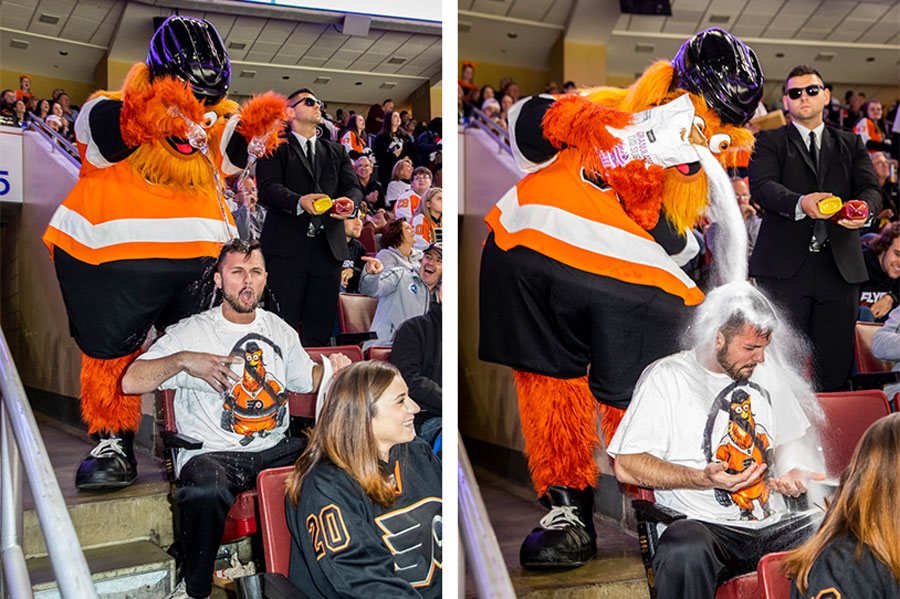
Photographs by Steve Boyle.
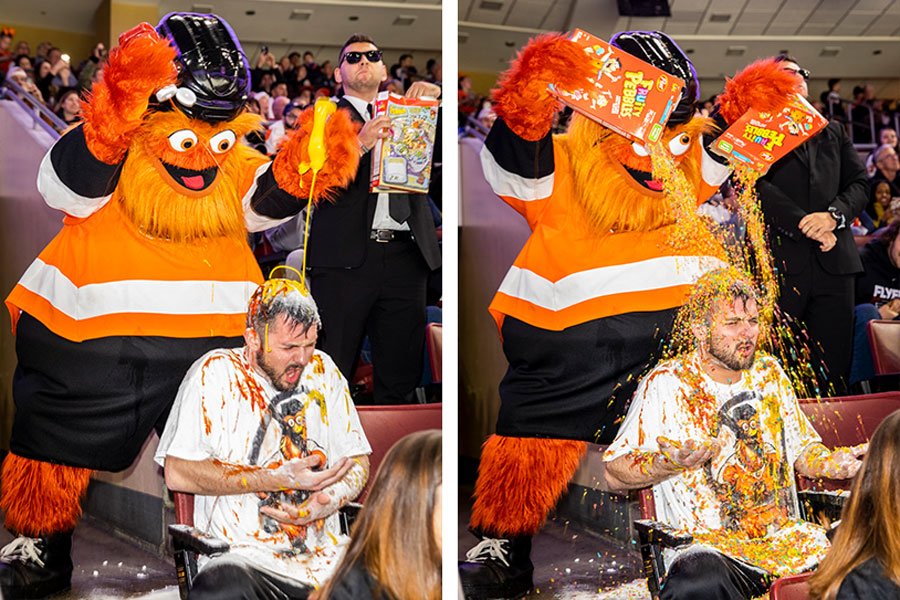
Photographs by Steve Boyle.
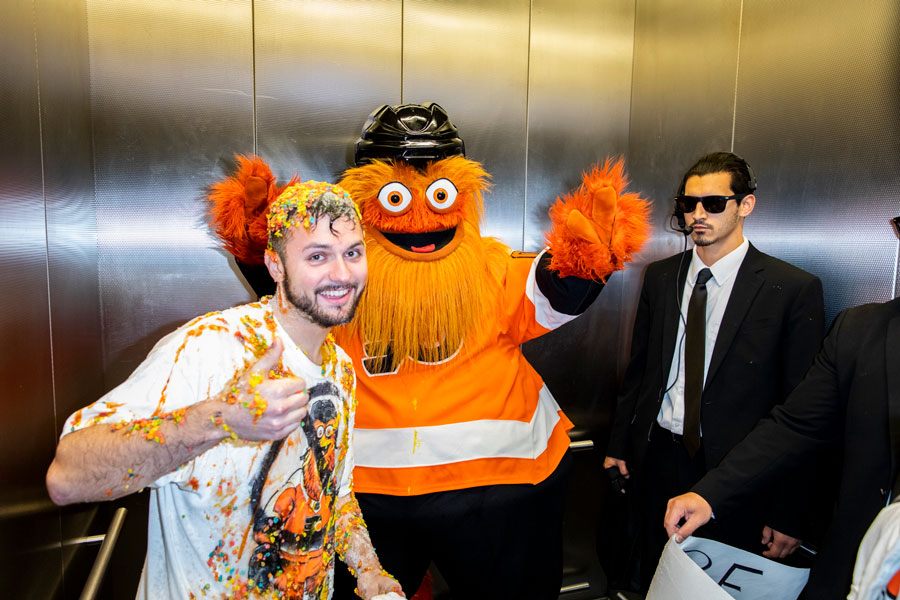
Photograph by Steve Boyle.
When you live in the home of the greatest sports mascot of all time, your first call is a no-brainer. The Flyers reached out to David Raymond. He’s a “character branding” expert who’s done a TED talk on “The Power of Fun.” But he’s best known here as the original Phillie Phanatic.
“When we first met with Dave, he said you need to be prepared for maybe a couple of months of really, really intense backlash,” remembers Cindy Stutman, SVP of business operations. “Whatever the joke about him is, whatever people are really piling on about, embrace it. Have as much fun as people are having making fun of him.”
It’s how the bullied defang bullies and how stand-ups defuse hecklers. “If someone’s really shooting arrows at you and you laugh at it, if you say, ‘You’ve cut really deep with that one, but it was funny,’ they’re like, ‘Oh, thank you,’” Raymond says in his memorabilia-laden home office in West Grove, Pennsylvania. “That’s really the brilliance of what the Flyers did.” Case in point: Gritty’s infamous spill on the ice during its first game had the makings of disaster. Instead, Gritty did snow angels.
The two big keys to a successful mascot launch, says Raymond, are a great backstory and a firm commitment. Gritty’s origin tale — it’s a hot-dog-munching monster discovered in the bowels of the Wells Fargo Center — is already legend. And the commitment, so obvious amid the onslaught of ridicule that followed the launch, was also evident in the weeks leading up to it.
Before a single swatch of fur was ordered, the big question was just what kind of mascot the Flyers wanted. Heller and his team — which includes Anthony Gioia, who’d previously created and performed as the Carolina Hurricanes mascot Stormy — sorted through hundreds of designs representing everything from humans to monsters to the aforementioned bull that came from Raymond’s outfit. Eventually, there were two finalists: a kinder, gentler beast, which became thought of as the “safe” option, and a proto-Gritty monster drawn by Brian Allen of Flyland Designs in Bellefonte, which pushed the envelope.
“We made a conscious decision as an organization that we were going to lean in,” says COO Shawn Tilger. Here, “leaning in” meant going for broke with a googly-eyed freak.
In a way, the riskier option was the only option. Looming over the process was a simple question: What would Ed Snider, the longtime Flyers chairman and exacting old-schooler who died in 2016, have thought? You get the sense from talking to those who knew Snider that he’d likely have been … skeptical. “But the one thing about Mr. Snider is, he was a pretty good listener,” recalls Paul Holmgren, the Flyers-lifer team president and fellow hockey purist. “He hired people to do their jobs. He might argue with you, but he’d listen to you. I think there’d have been pushback on this, but at the end he’d have said, ‘Okay.’ And two days later, when Gritty took off, he’d say, ‘I told you Gritty was going to be good!’” Snider valued aggressive, well-executed plans in service of what was best for the organization — and it’s hard to argue that Gritty has been anything but phenomenal for a franchise that just a few months ago felt like an afterthought around town.
The biggest difference between launching a mascot today and when Raymond birthed the Phanatic in 1978 is social media. In real life, mascots tend to be mute, limited to the language of physical comedy. In this respect, the Flyers’ mascot is top-notch. On Gritty t-shirt night in October, it showed off the moves that have endeared it to the fan base. It descended upon an audience “plant” who had a “Fire Gritty” sign and showered him with Fruity Pebbles and condiments.
During an intermission, Gritty drew a “penalty” in the Mites on Ice youth hockey scrimmage, then trashed the penalty box in hilarious goon pantomime. It’s comedy gold, but fairly limited to the arena. Online, though, the characters can really mix it up with the masses. And Gritty’s social media squad is on point. Aiding the performer himself — whose identity is a closely guarded secret — is a three-headed hive mind of Christine Mina, Lauren Robins, and marketing/communications coordinator Lauren Capone. The soft-spoken Robins is, per her colleagues, the impish creative genius of the group; for instance, she masterminded the internet-crashing “Kim Kardashian” tweet at the conclusion of the mascot’s first day — the one where Gritty, back to the camera, spouts an arc of Gatorade into a champagne glass balanced on its ass.
These three, with the performer, have gradually honed the mascot’s online voice, converting the confused and sniping back at the haters with one well-timed, well-toned tweet after another. This could be the best lens through which to view the phenomenon wherein Gritty has essentially escaped its cage and the relatively narrow confines of the NHL.

Photograph by Steve Boyle.
Days after Gritty’s debut, versions of its face started showing up on protest posters. There was the all-black antifa banner at President Trump’s October Philly visit that broadcast GRITTY SAY G.T.F.O. OF PHILLY. More recently, a sign proclaiming ONLY GRITTY IS ABOVE THE LAW graced a Center City protest of Jeff Sessions’s firing. And there have been so many memes, about socialism and drugs and killing fascists.
The company line is that Gritty isn’t a political animal. “He barely knows his right from his left,” chuckles COO Tilger. But in the Year of the Woman and the era of #MeToo, is it really so surprising that three millennial women are, as Mina puts it, the “snappy personality” of this most 2018 of phenomena? After all, Gritty wasn’t born in a vacuum; it was birthed into the national self-flagellation around the Christine Blasey Ford/Brett Kavanaugh accusation and the finishing moves of the Bill Cosby sentencing. The state of the world was very much on the team’s mind even as it tiptoed through that minefield.
In the immediate aftermath of the launch, “We had so many social posts that were like, ‘This is the best thing in the news right now,’” recalls Robins. “It was kind of a really dark time, and we just brought this light with the mascot. That made me so happy apart from Philadelphia and the Flyers — that we were bringing some happy news and positivity into everything.”
And this, ultimately, is why liberals have latched onto Gritty — why Gritty has become the left’s answer to the alt-right emblem of Pepe the Frog. The Flyers were on their heels, losing the battle for Philly sports fans’ hearts and minds. This sense of desperation surely permeated a process that birthed a creature whose empty, half-cocked gaze has proven such a ready vessel for oppositional indignation from the left, a tribe that itself had felt left for dead. The Flyers needed a mascot. So did the Resistance. And the convergence of crazed, wild-haired, googly-eyed despair is precisely why the two have become one.
Published as “Viva la Gritty” in the January 2019 issue of Philadelphia magazine.


